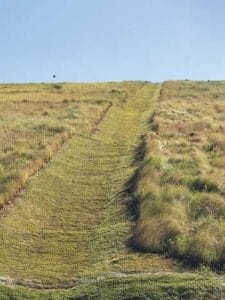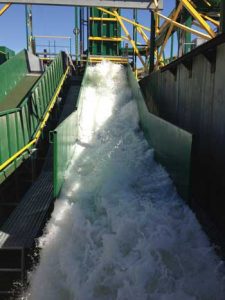Using an engineered synthetic turf system to manage storm water at landfill sites addresses multiple issues while improving performance and reducing costs.
By Krista Willey
Handling concentrated flows of water at landfills presents multiple challenges when it comes to managing storm water. Typically, these systems consist of applications such as downchutes, perimeter channels, bench drains, outfall structures and basins to appropriately route water off of the landfill. It is important that these drainage structures be lined with materials that will protect against erosion in order to avoid failure, ongoing maintenance and potential violations. The least expensive option is a vegetated lining. However, it is ineffective for concentrated flows that are above 5 ft./s. in velocity. Natural vegetation requires significant maintenance activities including re-seeding, fertilizing, watering and mowing. Infertile cover soils and landfill gas make it even more difficult to grow natural vegetation. Since the vegetation is permeable, rainfall and storm water will infiltrate interim covers and produce additional leachate. The poor performance and long-term cost to maintain this kind of lining coupled with the increased risk of leachate have led engineers toward hard armor systems to convey storm water.
Performance Challenges
While these hard armor systems are an improvement over vegetated solutions, they can be expensive and provide their own performance challenges. For example, concrete drainage systems are costly, time-consuming to install and settle over time, causing them to crack, undermine and fail.
Other revetment options like rock riprap can have poor hydraulic performance and require continuous maintenance. Also, installation of riprap requires large equipment and numerous truckloads of material traffic, which makes it difficult to install on slopes and in difficult access areas. For example, it can take up to 50 truckloads of riprap to cover a typical landfill site with two 100-foot downchute channels. Because it is permeable, storm water can undermine the riprap. This will cause erosion, blow-outs and the potential for increase leachate, resulting in costly repairs and maintenance.
Other systems such as gabions and articulated concrete blocks (ACBs) are expensive and time-consuming to install. Also, their hydraulic performance is significantly inhibited under settling conditions.
Pipe drainage is relatively inexpensive to install, but very expensive to maintain. Pipes clog with sediment and trash, so they need to be cleaned out regularly. Also, for downchutes it is difficult to flow storm water correctly into the pipes. Often, storm water will go around or under the flared end section causing erosion along the pipe down the slope. Additionally, pipes will split at the joints due to erosion along them or due to settlement of the landfill. In essence, pipe drainage may be a relatively inexpensive upfront cost, but they require significant and constant maintenance.
Over the last decade, new civil and environmental technologies have emerged that are more effectively solving the storm water problems that arise on traditional landfills. A proven geosynthetic, known as an engineered synthetic turf system, is an effective and economical alternative to traditional hard armor revetment solutions such as rock riprap, pipe, concrete and ACBs. In fact, using engineered turf to manage storm water at landfill sites is becoming more prevalent as it meets all 40 CFR 258.6 requirements for Run-on/Run-off Control Systems and has the additional advantages of superior performance and reduced costs. The patented system is made up of three components—a structured geomembrane, an engineered synthetic turf and a specialized cementitious infill.
Using engineered turf to manage stormwater at landfill sites solves erosion control problems, minimizes infiltration and reduces maintenance.

in well with natural surroundings.
Erosion Control
Erosion control becomes a non-issue when geosynthetic products are installed. Designed specifically for landfill applications, this revetment solution will flex and move with typical differential settlements without compromising performance. Backed with full-scale laboratory testing, it provides superior hydraulic performance capable of handling large flows resulting in very high velocities. When tested at the world’s largest hydraulic testing flumes at Colorado State University, the engineered synthetic turf system did not reach failure at a maximum steady state overtop velocity of 40 ft./s. and for 13 hours in the wave overtop simulator being subjected to a generic 500-year hurricane event. It was hit with the maximum flows of the CSU test facility with no erosion, instability or damage to the system. Another benefit of the engineered synthetic turf system is significantly reduced sediment loading in channels and sedimentation/detention basins both on and offsite. Because of the integrity and superior performance of the engineered turf as a revetment solution, landfill managers reap cost savings benefits on upfront construction as well as long-term maintenance since the engineered turf does not have the problems of other revetment systems (i.e., cracked concrete, clogged pipes, displaced riprap).
Minimize Infiltration
When the engineered turf system is used in landfill ditches, the problems with infiltration and the resulting leachate are drastically reduced. This impermeable revetment solution has the ability to effectively manage large quantities of water and because the product acts as a barrier on the landfill surface, no additional liquids are introduced into the landfill. The system adequately filters the storm water and the end result is clean runoff with very low turbidity. This practice saves money and reduces the cost of leachate treatment.

Minimal Maintenance
With the engineered turf system, you do not face those significant maintenance costs related to maintaining vegetation and erosion control. These systems will not erode, undermine, split or become ineffective over time. This technology requires the least amount of maintenance of all other revetment systems. Studies show that maintaining a vegetative cover/ditch is about $1,000 to $1,200 per installed acre per year and engineered turf systems cost between $100 and $150 per acre per year. This substantial savings combined with the superior performance under intense hydraulic flows and its 50+ year functional longevity make the engineered turf an exceptional choice to drastically lower long-term maintenance budgets.
Other key advantages to engineered turf technology are cost, construction and sustainability. The installed cost is typically up to 20 to 40 percent less than concrete, rock riprap and/or articulated concrete block. Construction of the system is rapid, low impact and scalable. Only small, lightweight construction equipment is needed for installation. This innovative, environmentally friendly, alternative offers a lower carbon footprint (75 to 85 percent less) than other traditional revetment solutions. The engineered turf has an added aesthetic benefit as it looks like natural grass. It is offered in six color styles to best match the native vegetation.
In summary, using an engineered synthetic turf system to manage stormwater at landfill sites addresses multiple issues while improving performance and reducing costs.
Krista Willey is Vice President of Marketing at Watershed Geo (Alpharetta, GA), an environmental solutions company offering unparalleled geosynthetic options for both civil and environmental applications for erosion control, soil stabilization and waste containment. Solutions include, ClosureTurf®—a final closure technology, HydroTurf®—a revetment technology for storm water applications, and VersaCap®—an intermediate cover for erosion, leachate and gas control. Krista can be reached at (770) 777-0386, via e-mail at [email protected] or visit www.watershedgeo.com.
